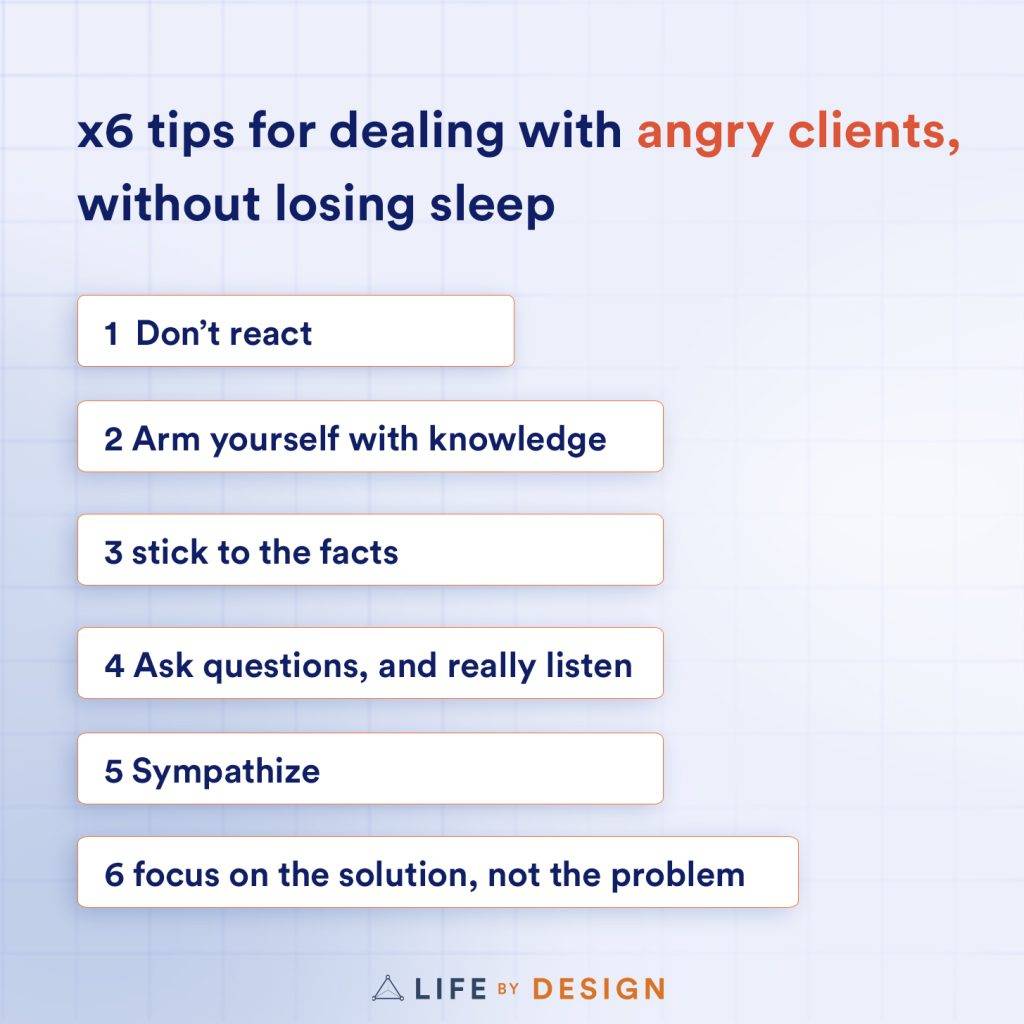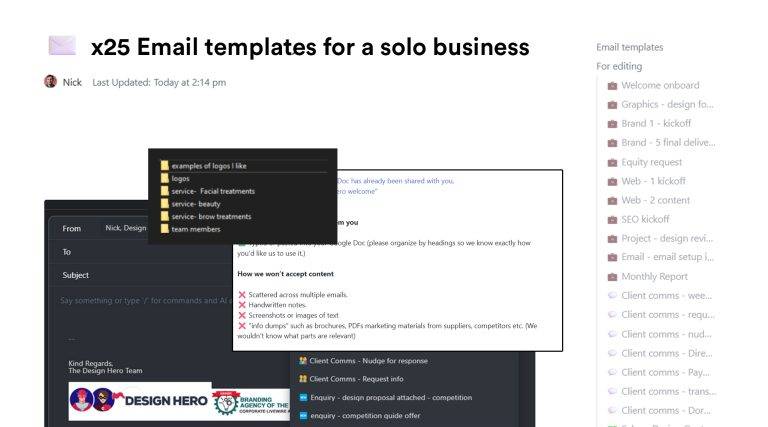This week one of my team got caught in the cross-fire of an angry client.
They ended up giving away a free landing page for no reason:
the problem wasn’t ours to fix.
In short, they panicked.
We’ve all been there at some point…
You might just be the best freelancer in the world,
if you’ve done everything right,
if your patient, generous, forgiving and kind,
if you go the extra mile…
One dark day you will still be faced with the nasty experience of an angry client blaming you for their problem.
If you’re in the freelancing game for long enough, eventually this will happen to you.
It can be so unpleasant it keeps you up for nights in a row,
or makes you want to quit altogether.
It can make even the most seasoned freelance feel the crush of self-doubt,
that burning rage of injustice,
or the heart-clenching stress of inter-personal conflict.
So now that you know what awaits you,
let’s arm you with the tools you need to deal with it,
without losing nights of sleep over it.
Here’s the playbook and toolkit I gave my team for dealing with upset, irrate or even angry clients…
We’ll cover x8 ways to deal with angry clients, without losing your sh*t.
- Understand why
- Don’t react
- Stick to the facts
- arm yourself with knowledge
- Ask questions
- Sympathize
- Shortcut to the solution
- Setting boundaries

let’s dive in…
First, understand what happens when you are confronted by an angry client…
It’s easy to get caught offguard and derailed when confronted by an angry customer.
It’s no different from a physical confrontation and your body goes through a unique set of changes:
- Your pupils will dilate
- your heart rate will rise,
- you will sweat,
Your brain will enter “fight or flight mode”,
All the valuable, logical stuff you learn in this article will be lost to you,
as type 1 reactionary, emotional thinking takes over.
The connections to your logical, long-term memory are cut off.
So your first instinct will be to appease, or to fight back.
Under these conditions you will make silly mistakes, like:
- arguing back adding fuel to the fire,
- avoiding the argument until it turns into a volcano
- giving away all sorts of freebies and conciliation prizes out of guilt for things weren’t your fault.
You must fight your monkey brain instinct to throw poo or run,
because your first reaction should be no reaction at all.
Don’t react emotionally
Whatever you do don’t ever let you emotions control the conversation.
The moment you lose your temper, raise your voice, break out or lash out,
you’ve lost the game.
That emotional outburst will be the defining point of your entire client relationship.
At that point you can throw all logic out the window because now you are having an “emotional” argument where there is no winner.
Even if the client hasn’t paid in 6 months,
changed the brief 6 times
and took a crap in the passenger seat of your car at the last client meeting,
it doesn’t matter; you shouted at them and a business shouldn’t shout at customers, so they’ve won the dispute.
Remove emotion from the equation
We get angry because the when the client questions our price, our service etc they are questioning our competence and trustworthiness as a person.
By all means after your call go rant and rave and punch some walls,
but during the call let their comments wash over you, stick to the facts and don’t get drawn into a tit for tat.
You can tell the client calmly that you’re confused, hurt, disappointed etc.
But do it calmly and professionally.
Personally, I prefer to leave my own feelings out of it entirely,
and just stick to the facts…
Stick to the facts
Something strange happens when reasonable people become entrenched in an argument…
Even if the argument starts out as minor, both sides stop trying to reach the solution, and start trying to win the argument.
They start to justify their own increasingly extreme position, by inventing and exaggerating injuries.
The argument becomes increasingly convoluted and nonsensical.
It’s known as “confirmation bias”;
If you try to correct or address every half truth, every incorrect fact, every misconstruction in the dispute you’ll be there all day.
When a client lists multiple points they are just trying to add “points” to their argument, and justify the dispute in the first place.
If someone is angry, they will find a reason to justify their anger.
Your job is to help them to not be angry, and give them reasons to be reasonable.
Ignore specific points, no matter how frustrating your find them.
Only address the main point in question, ad there’s nothing to add, simply reiterate your first point.
Hi there just to clarify, your invoice was issued on 01/06 and was due 14/06.
We have a 2 week grace period, built on trust from our previous work together, but unfortunately we cannot continue the project until this invoice is paid.
To keep your project progressing in timely manner please attend to this as soon as possible.
The facts will keep you straight, when emotion is leading you on a tangent.
Arm yourself with knowledge
If you know you’re heading into a battle with someone, you’ll want a weapon.
You are a knowledge worker, so your weapon is knowledge
Forewarned is forearmed so arm yourself with these facts:
- What is the client history?
- What are their red flags and preferred communication methods?
- What result did we promise to get them, and have we done our job?
- What was the scope we were paid for?
- What are the numbers, dates, key points?
You won’t always have the luxury of being forwarned though,
so let’s discuss what to do if you weren’t expecting an argument…
Why Clients get upset
It’s important to understand there are no bad clients, only badly managed clients.
Your client always has a reason for behaving the way they do,
even if it’s not apparent to us at the time.
Here’s the most common reasons dogs misbehave:
- No-one is taking charge, so the feel like they need to be boss.
- They are afraid or insecure
- They have been bitten in the past (this is common and explains a lot of bad behaviour).
- At grannies, they are allowed to sleep on the sofa, they are not used to been told “No”
- They have learned to get what they want by barking at people
- You promised a steak, but you haven’t given it to them yet…
- They don’t understand how you want them to behave.
Clients misbehave for the same reasons.
As much as you’d like to smack them on the bum with a newspaper,
lets try a different method that works really well for me on people…
Ask questions
The anger the client is expressing may just be frustration in disguise.
the thing they are panicking about is a usually just a symptom of the real problem.
Allowing the client to vent their frustration can be incredibly cathartic;
they may turn into a nice client again!
- Why are they upset?
- What about?
- Why
You must tease this out of them before proceeding.
Ask broad open-ended questions.
and really listen to the answers.
Listen
This give the client a chance to vent their frustration generally,
instead of directing it at yourself.
Once you understand their actual problems you can sympathise and even empathize, even if you don’t agree on the specifics or the blame.
Sympathising with that frustration and working with them to a solution is the best route forwards.
Sympathize
Remember…
Pushing boundaries is just human.
People will naturally offload their own mental load and problems onto others.
Clients have their own priorities, which are usually not aligned with yours.
Override your instinct to get annoyed or pushback
Your job is to try to be helpful and help as much as you are willing,
but also to decide in advance where the line is drawn so you aren’t caught off guard.
Give people the benefit of the doubt,
Give the benefit of the doubt
Don’t take things personally.
I try to always give my clients the benefit of the doubt,
Running a business is a high stress job, even when things are going right.
They may have been up all night with a sick kid.
They may have personal issues
They may have financial pressure or deadlines
People have bad days.
Allow for this.
🦜 Defuse the tension by parroting
This is where a live discussion is much more powerful than an email.
It’s tempting to hide behind a keyboard and avoid a real-time conversation,
but an email is a one-way exchange, not a discussion.
Generally avoid dealing with disputes over email.
the written format tends to lead towards escalation and nitpicking.
A single dispute emails can take hours, and lead to a dozen more points to dispute.
I myself have sat drafting, editing, rewording, cross checking and analyzing a single email to a single client for half a day.
Now I usually take only 10 minutes to reply max, because I have a better strategy:
Only address the main point in question, ignore the urge to respond to every tangents, and simply repeat your first point.
I’ve written a full guide on responding to angry emails from clients here.
Generally, instead of wasting time discussing the problem,
spend time on working towards the solution.
I’m going to share a technique with you right now.
This one thing alone will flip the script on dozens of arguments…
Parrot the problem back at them.
This helps them feel understood.
Understand without condoning or judging:
Oh ok, so your annoyed because you feel like we haven’t been able to get this done in time for your big event this weekend?
I totally get it, you’ve got a big deadline and there’s a lot riding on this for you.
one second ago you were the antagonist,
Now your the sympathetic ear,
and better yet, you’re going to help them to the solution…
Focus on the solution, not the problem.
The solution may be extreme, such as parting ways as amicably as possible
But I will still work with them towards the solution as smoothly as I can, despite what I feel about their lack of organisation.
More often, the solution is setting a gentle boundary, then working towards the result they want on better terms 👇
So unfortunately we don’t normally do same day turnarounds, it woudn’t be reasonable to expect us to get this done for tomorrow since we’ve just heard about it, but what I can do is apply a rush fee on this job and put in some overtime tonight to get this turned around for you would you like to do that?
Setting boundaries
This response is reasonable, but also sets a boundary.
We want to help,
But also we don’t want to let people beat you us submission or bully us to their will…
As someone who was bullied all the way through school, I take a hard line on this type of behaviour now.
There is an art to say no to clients in a polite way whilst still being firm.
In fact I’ve written a whole book about managing clients.
It’s a bit like training dogs:
If you give your dog a snack when he’s begging and behaving badly, what does he do?
Is he really grateful for your generosity and never begs again?
No, he learns that by begging he can get what he wants.
Puppies and children both learn at a very early stage how much you can, or can’t, be pushed.
This is counterintuitive to freelancers, who like to people please.
Don’t feel bad about it, it doesn’t mean your a pushover, it means your a generous person.
You can be direct and blunt, without being an arse.
If you don’t do this,
if you cave and do the favour in bad faith,
if you avoid the problem,
it only leads to a bigger conflict later.
Tricky clients push your boundaries until you say no.
and if you don’t say no they’ll continue to take advantage.
If you are fair, but strict, they won’t like it at first.
In the short term they may be annoyed at you,
But this is better than pleasing the client one time, then having a project that is really badly run for months.
Give a reason why
Studies show people are more compliant, understanding and reasonable when a reason is given.
The funny bit?
Logical reasons are better but any reason will do.
The policy is that I have to charge a rush charge for any work that needs a rapid turnaround, because I have to pull my team off of other projects and may have to pay them overtime
The policy is we can only accept content via the Google Doc, so that we don’t miss anything
The policy is if it’s extra work outside the scope, it’s billable, so that I can cover the extra time
Mindset adjustment
Dealing with arguments is never nice.
but it’s helped me avoid a few sleepless nights of hanging onto useless anger.
It’s all part of the game of managing clients
you can get annoyed and lose sleep over it,
or you can see it as part of the game.
Someone wise once said:
“your success in life is measured by how many awkward conversations your willing to have.” – not sure who?
This is just another skill to learn on your way to becoming a 6 figure solopreneur.
The strategies I’ve outlined here are hard to remember when in the thick of it;
the only way to get good at it is practice.
You can’t go around deliberately pissing off your clients so you can learn how to deal with them 😅
Angry clients are quite rare (I hope)!
So the reps for feedback and learning on this are slow.
As with most things, you just have to learn the hard way:
Time and repetition.

Setting healthy boundaries doesn't have to be hard.
Subscribe for instant access to x50 foolproof email templates to set boundaries with clients.
















